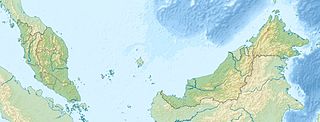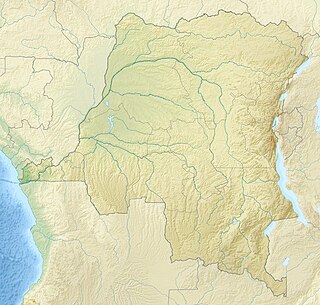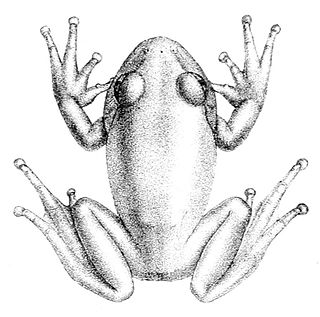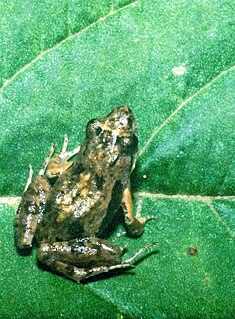
Ptychadena is a genus of frogs in the grassland frog family, Ptychadenidae. They are distributed in Sub-Saharan Africa as well as nilotic Egypt. The common names of this genus are ridged frogs and grass frogs.
Arthroleptis lameerei is a species of frog in the family Arthroleptidae. It is found in northeastern Angola, southeastern Democratic Republic of the Congo, and western Burundi, though the exact range is poorly known. There is some doubt whether it is distinct from Arthroleptis xenochirus. The specific name lameerei honours Auguste Lameere, a Belgian entomologist. Common names Lameere's squeaker, Lameer's squeaker, and Katanga screeching frog have been coined for this species.

Ansonia guibei is a species of toad in the family Bufonidae. It is endemic to northwestern Sabah in Malaysian Borneo. The specific name guibei honors Jean Guibé, a French zoologist and herpetologist. Common names Mesilau toad and Mesilau stream toad have been coined for it.
Mertensophryne melanopleura is a species of toad in the family Bufonidae. It is known from its type locality, the Upemba National Park in southern Democratic Republic of the Congo, and from eastern Angola and south of Ndola in northern Zambia.
Leptopelis oryi, also known as the Garamba forest treefrog and Ory's tree frog, is a species of frog in the family Arthroleptidae. It is found in the northeastern Democratic Republic of the Congo, northwestern Uganda, and adjacent South Sudan. It is morphologically similar to Leptopelis nordequatorialis from Cameroon, and has also been considered its synonym, but is currently treated as a distinct species. The specific name oryi honours Albert Ory, warden in the Garamba National Park, the type locality of this species.

Leptopelis parvus, also known as the Kanole forest treefrog, is a species of frog in the family Arthroleptidae. It is endemic to the Democratic Republic of the Congo and is only known from the Upemba National Park.

Leptopelis viridis is a species of frog in the family Arthroleptidae. It is widely distributed in the West and Central African savanna zone between Senegal and the Gambia to the northeastern Democratic Republic of Congo.
Phrynobatrachus parkeri is a species of frog in the family Phrynobatrachidae. It is endemic to the west-central and northeastern Democratic Republic of the Congo. It is only known from a few widely separated localities. It is similar to Phrynobatrachus acridoides(Cope, 1867), and it might be a synonym of the latter. The specific name parkeri honors Hampton Wildman Parker, an English zoologist and herpetologist. Common name Parker's river frog has been coined for it.

Phrynobatrachus parvulus is a species of frog in the family Phrynobatrachidae. It is widely distributed in the upland areas of Central and East Africa in Angola, northern Botswana, northern Zimbabwe, Zambia, southeastern Democratic Republic of the Congo, Malawi, and Tanzania. However, many identifications are problematic, and the taxonomic status of this species with respect to Phrynobatrachus mababiensis and P. ukingensis requires clarification; in the more inclusive species delimitation applied by the IUCN SSC Amphibian Specialist Group, also Uganda is tentatively included in the range of this species. Common names Loanda river frog, dwarf puddle frog, and little puddle frog have been proposed for this species.
Phrynobatrachus rungwensis is a species of frog in the family Phrynobatrachidae. It is found in southeastern Democratic Republic of the Congo, central and northern Malawi, and east to southern and central Tanzania. It is also expected to occur in northeastern Zambia. Common names Rungwe puddle frog and Rungwe river frog have been coined for it. It is named after Mount Rungwe, its type locality.
Ptychadena harenna is a species of frog in the family Ptychadenidae. It is endemic to Ethiopia and only known from its type locality at the foothills of the Bale Mountains, in the Bale Mountains National Park. The locality is within the Harenna Forest, and common name Harenna Forest grass frog has been coined for it.
Ptychadena ingeri is a species of frog in the family Ptychadenidae. It is endemic to the north-eastern Democratic Republic of the Congo where it is known from the Garamba National Park. It is likely to occur more widely, possibly reaching into South Sudan. It is named after Robert F. Inger, an American zoologist from the Field Museum of Natural History. Common name Inger's grassland frog has been coined for it.
The Mozambique ridged frog is a species of frog in the family Ptychadenidae. These frogs can swim fairly well, jump far and can crawl with ease through dense plants. Their strong hindlegs can launch them up to three metres into the air in a single bound.
Ptychadena nana is a species of frog in the family Ptychadenidae. It is endemic to Ethiopia. It is only known with certainty from its type locality, Arussi Mountains, in the Ethiopian Highlands; these mountains are also referred to as the Arsi Mountains. There is uncertainty regarding reports from elsewhere, which perhaps refer to other, possibly undescribed species. Freilich and colleagues found specimens from the Bale Mountains to be larger than "normal" Ptychadena nana, but that molecular data clustered them with other P. nana. Common names Somali grassland frog and smallest grass frog have been coined for it.
Ptychadena perreti is a species of frog in the family Ptychadenidae. It is found in Cameroon, Gabon, Republic of the Congo, southwestern Central African Republic and northern Democratic Republic of the Congo. It might occur in the Cabinda enclave of Angola and mainland Equatorial Guinea. Common name Perret's grassland frog has been coined for it.
Ptychadena submascareniensis is a species of frog in the family Ptychadenidae. This West African frog is found on the Nimba Range of Ivory Coast, Guinea, and Liberia, and on the Loma Mountains of Sierra Leone.
Ptychadena tournieri is a species of frog in the family Ptychadenidae. It is a widespread species in West Africa and found in Senegal, Gambia, Guinea-Bissau, Guinea, Sierra Leone, Liberia, and Ivory Coast, as well as in Togo and Benin; it is assumed to occur in Ghana and southeastern Burkina Faso, although it has not been recorded there. On the other hand, some records may refer to other species; the Amphibian Species of the World excludes Gambia and Togo from the distribution. Common names Liberia grassland frog and Tournier's rocket frog are sometimes used.
Ptychadena trinodis is a species of frog in the family Ptychadenidae. Its common name is Dakar grassland frog. It is widely distributed in West and Middle Africa, and following the International Union for Conservation of Nature (IUCN), occurs in Benin, Cameroon, Central African Republic, Chad, Democratic Republic of the Congo, Gambia, Ghana, Guinea, Ivory Coast, Mali, Mauritania, Nigeria, Senegal, and Togo. Further, records are missing from Guinea-Bissau, Burkina Faso, Niger, South Sudan, and Sudan, but it is presumed to be present in these countries too.
Ptychadena uzungwensis is a species of frog in the family Ptychadenidae. It is found on the East African Plateau in Rwanda, Burundi, and Tanzania in the north and then southward to eastern Democratic Republic of the Congo, northern Angola, Zambia, Malawi, Zimbabwe and uplands of Mozambique. Its common names include Udzungwa ridged frog and Udzungwa grass frog, where "Udzungwa" may also be written Uzungwa, following the spelling that Arthur Loveridge used in the species description for the Udzungwa Mountains, the type locality.
Ptychadena wadei is a species of frog in the family Ptychadenidae. It is endemic to Ethiopia and only known from a small area southeast of Lake Tana, in the upper reaches of the Blue Nile. The specific name wadei honours Edward O.Z. Wade, an English illustrator and herpetology enthusiast who drew some of the illustrations accompanying the species description. Common name Wade's grass frog has been coined for it.





